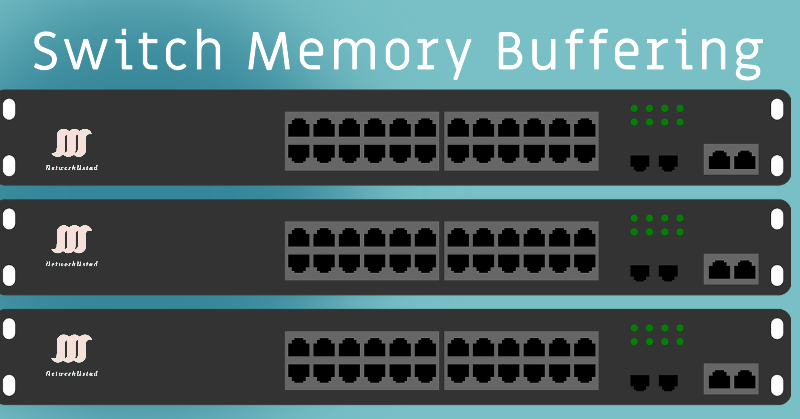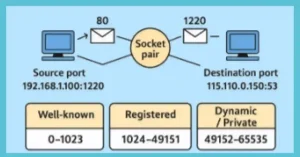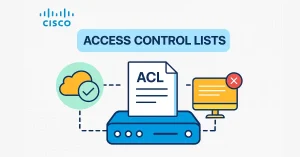Ethernet switches employ memory buffering to manage data traffic efficiently, ensuring frames (data units) are temporarily stored when destination ports face congestion. Effective buffering is crucial to prevent frame loss, which can degrade network performance, increase latency, and trigger retransmissions, ultimately impacting user experience and reliability. This article explores buffering methods, their evolution, and their role in modern networking.
Core Buffering Techniques
1. Port-Based Memory Buffering
How It Works:
Each port has dedicated high-speed memory buffers. Frames are queued per port and are waiting for transmission even if other ports are free.
Advantages:
- Predictable Allocation: Guarantees buffer space per port, ideal for stable traffic patterns.
- Simplicity: Easier to implement in hardware due to fixed queues.
Disadvantages:
- Head-of-Line (HoL) Blocking: A busy destination port can delay all queued frames, even those bound for idle ports.
- Resource Inefficiency: Static allocation may waste memory if some ports are underutilized.
- Frame Drops: Exhausted port buffers lead to dropped frames during traffic spikes.
Real-World Example:
Legacy switches like the Cisco Catalyst 2900 series use port-based buffering, which is suitable for environments with predictable traffic, such as small office networks.
2. Shared Memory Buffering
How It Works:
A global memory pool is dynamically allocated across all ports. Frames are stored in a shared space and linked to their destination ports.
Advantages:
- Dynamic Allocation: Efficiently uses memory by assigning buffer space as needed.
- Reduced Frame Drops: Flexibility allows congested ports to borrow buffer space from idle ones.
- Cross-Port Efficiency: Frames can move directly from input to output ports without requeuing.
Disadvantages:
- Complexity: Requires advanced management algorithms to avoid buffer monopolization.
- Cost: Higher memory demands and sophisticated hardware raise implementation costs.
In 2025, buffering techniques are increasingly tailored for emerging technologies like edge computing, where low-latency requirements drive innovations in buffer management.
Technical Insight:
Cisco’s early Catalyst 3500 switches utilized shared buffering, leveraging algorithms like Dynamic Threshold to allocate memory proportionally based on real-time demand.
Advanced Buffering Techniques
Modern switches combine methods to address limitations:
- Virtual Output Queuing (VOQ): Eliminates HoL blocking by maintaining separate queues per destination port within the shared memory. Used in high-performance data centers.
- Quality of Service (QoS) Integration: Prioritizes critical traffic (e.g., VoIP) using weighted or priority queuing, ensuring low latency for high-priority frames.
- Hybrid Approaches Merge port-based and shared memory, offering static buffers for key ports while dynamically sharing the remaining memory.
AI-driven buffer optimization, leveraging real-time traffic analysis, is gaining traction in 2025 to predict and mitigate congestion in hyperscale data centers.
Buffer Management and Sizing Considerations
- Buffer Size Determination: Depends on port speed, network latency, and traffic patterns. For example, 10 Gbps ports require larger buffers than 1 Gbps to handle bursty traffic.
- Management Algorithms:
- Static Threshold: Predefines buffer limits per port.
- Dynamic Allocation: Adjusts thresholds in real-time using metrics like queue depth.
As of 2025, buffer sizing also considers AI-driven traffic forecasting to dynamically adjust for unpredictable workloads in cloud-native environments.
Comparison of Buffering Techniques
| Feature | Port-Based | Shared Memory |
|---|---|---|
| Resource Efficiency | Low (fixed allocation) | High (dynamic allocation) |
| HoL Blocking Risk | High | Low |
| Frame Drop Likelihood | Higher during congestion | Lower due to flexibility |
| Cost | Lower | Higher |
| Use Case | Predictable traffic | Dynamic, high-variability environments |
Future Trends and Conclusion
As networks evolve in 2025, buffering techniques adapt to support 400 Gbps speeds and software-defined networking (SDN). Innovations like programmable buffers and AI-driven traffic prediction optimize memory usage dynamically, ensuring resilience in an increasingly connected world.
By integrating historical methods with cutting-edge advancements, Ethernet switches continue to form the backbone of efficient data communication, balancing resource allocation and performance in an increasingly connected world.
FAQs
What is memory buffering in Ethernet switches?
It requires complex management algorithms to prevent one port from monopolizing buffer space. Implementation costs are also higher due to advanced hardware requirements.
What is the difference between port-based and shared memory buffering?
Port-based buffering allocates fixed memory per port, risking inefficiency and Head-of-Line (HoL) blocking. Shared memory buffering uses a dynamic global pool, allowing ports to borrow memory as needed, improving flexibility and reducing frame drops in high-speed networks.
How do fast-forward and fragment-free switching methods differ under cut-through?
Fast-forward starts forwarding frames as soon as the destination MAC address is read (first 6 bytes), offering the lowest latency but risking error transmission. Fragment-free waits for the first 64 bytes (collision window) to check for errors like “runt” frames before forwarding, balancing speed and integrity.
Which buffering method is better for high-traffic environments?
Shared memory buffering excels in dynamic, high-traffic environments like 2025 data centers due to its dynamic allocation and lower frame drop rates, while port-based buffering suits predictable, low-variability traffic.
How does shared memory buffering reduce frame drops?
By pooling memory across all ports, shared buffering allows congested ports to borrow buffer space from under-utilised ones, adapting to traffic spikes more effectively than fixed per-port allocations.
What are Virtual Output Queuing (VOQ) and QoS buffering?
-
VOQ eliminates HoL blocking by maintaining separate queues for each destination port within shared memory.
-
QoS buffering prioritizes critical traffic (e.g., video calls) using weighted queues to ensure low latency for high-priority frames.
-
How do switches determine buffer size?
Buffer size is determined by port speed, network latency, and traffic patterns. In 2025, 10 Gbps and 400 Gbps ports require larger, AI-optimized buffers to handle bursty traffic effectively.
Can switches use both port-based and shared buffering?
Yes! Hybrid approaches combine static allocations for critical ports with dynamic sharing for others, balancing predictability and flexibility.
What happens if a switch runs out of buffer space?
Frames are dropped, leading to potential retransmissions and increased latency. Proper buffer sizing and management algorithms help mitigate this risk.
Which Cisco switches use shared memory buffering?
Early models like the Catalyst 3500 series employed shared buffering with dynamic allocation algorithms to optimise performance.
How do modern switches handle congestion in data centers?
Techniques like VOQ, QoS prioritisation, and AI-driven traffic prediction are used to manage congestion in high-speed (e.g., 400 Gbps) environments.
What future trends will impact switch buffering?
Innovations like programmable buffers (via SDN) and machine learning-based traffic forecasting aim to optimise memory usage in real-time for evolving network demands.
Why might a network administrator prefer port-based buffering?
For simplicity and predictable resource allocation in stable networks with consistent traffic patterns, such as small office setups.
How does buffering affect network latency?
Excessive buffering can increase latency (bufferbloat), while insufficient buffering leads to drops. Modern switches use adaptive algorithms to balance these trade-offs.
Are there standards governing switch buffering techniques?
While buffering methods are vendor-specific, standards like IEEE 802.1Q (for QoS) provide guidelines for traffic prioritization and congestion management.
Can buffering techniques impact security?
Indirectly. Poor buffer management can lead to increased latency or drops during attacks (e.g., DDoS), but dedicated security features (like rate limiting) are separate.
How do software-defined networks (SDNs) influence buffering?
SDNs enable programmable buffer configurations, allowing administrators to dynamically adjust buffering strategies based on real-time network analytics.
What is bufferbloat, and how is it addressed?
Bufferbloat refers to excessive latency caused by overbuffering. Solutions include Active Queue Management (AQM) algorithms like CoDel (Controlled Delay) to limit buffer occupancy.
How will buffering evolve with 400 Gbps networks in 2025?
In 2025, 400 Gbps networks demand advanced buffering like VOQ and AI optimization to handle ultra-high-speed traffic, reducing latency and ensuring reliability.
Why is buffering important in network switches?
Buffering is crucial in network switches to temporarily store frames during congestion, preventing frame loss, reducing latency, and minimizing retransmissions, which enhances user experience and network reliability in 2025





